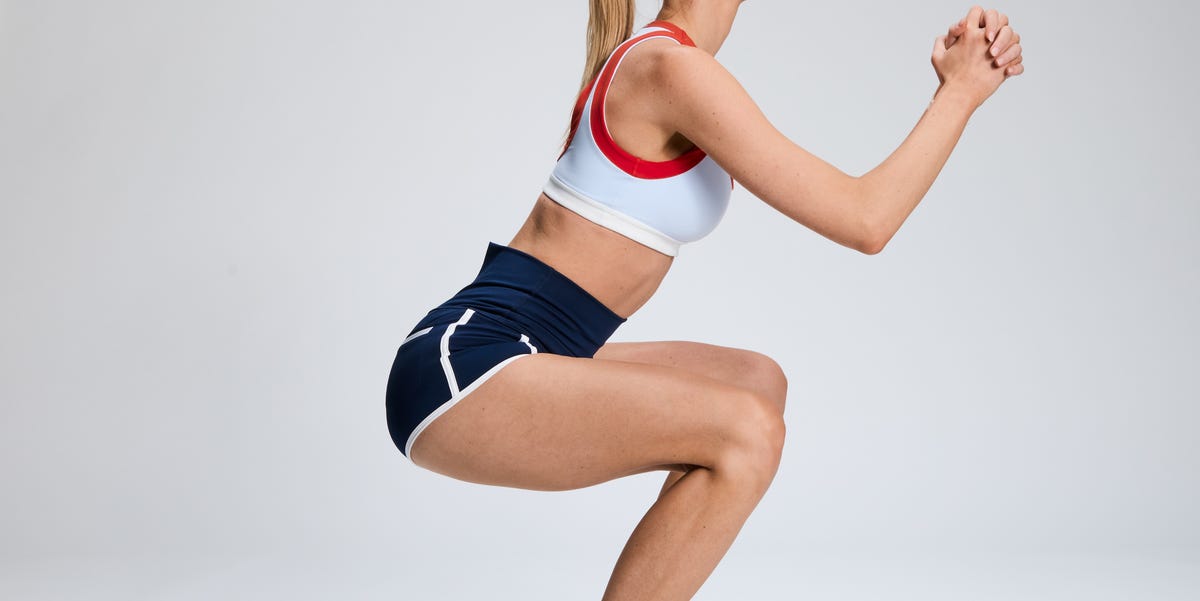Squats are one of the best lower-body exercises you can do. There are a million and one ways to keep ’em interesting and challenging and they’re also your ticket to glute gains.
But, before you get carried away with more complicated squat variations, you’re going to want to nail the not-so-humble bodyweight squat first. Whether you’re a beginner or advanced athlete, everyone can benefit from having this move in their repertoire.
“Bodyweight squats are underrated,” says trainer Sal Nakhlawi, USAW Level 2, founder of StrongHER Girls. “They’re a compound, functional movement you can do anywhere.”
Compound means that bodyweight squats work a bunch of muscle groups at once, firing up your quadriceps, hamstrings, glutes, hips, calves, and inner thighs, while also turning on your core. Functional, meanwhile, means they translate to real life. “Humans squat from the day they are able to walk,” Nakhlawi says. “We squat a lot in everyday life.” Think about it: How often are you getting up off a chair, picking something up off the floor, or climbing stairs? Squats make all those everyday actions just that much easier.
Meet the expert: Sal Nakhlawi, USAW Level 2, is a trainer and founder of StrongHER Girls.
So whether you’re brand-new to exercising or practically work out in your sleep, the bodyweight squat can do your fitness (and physique) plenty of good. Here’s everything you need to know about nailing the move—and making it harder when the time is right.
Benefits Of Bodyweight Squats
Squats are good for more than just making it easier to get off your super-plush couch; practicing bodyweight squats can help keep your body strong and injury-free.
Since bodyweight squats involve multiple major muscle groups, they help you build strength and muscle throughout your entire body—especially in your legs (including your glutes), back, and abs, says Nakhlawi.
The sweet secondary result of firing up so many muscles? You boost your metabolism, which burns more calories, she adds. Do ’em quickly and you’ll spike your heart rate and get in some cardio for a triple whammy of benefits with just a few simple squats.
Aside from getting you the most bang for your workout buck, bodyweight squats help your body move better all day long. Not only do they help improve your balance and coordination, but also develop mobility in your hips, ankles, and knees, Nakhlawi says. All good news if you want to feel strong and bendy in pretty much everything you do.
How To Do A Bodyweight Squat Properly
Of course, if you want to reap all those juicy squat benefits, you’ve gotta nail your execution.
How to:
- Stand with feet hip-distance apart, toes slightly pointed out, and arms at sides.
- Keep torso upright, engage core and glutes, shift hips back and down, and bend at knees to lower seat until thighs are at least parallel with floor.
- Drive down through heels to return to standing.
Common Bodyweight Squat Mistakes To Avoid
As simple as bodyweight squats may seem, there are a few common (and critical!) mistakes that can mess with their effectiveness, Nakhlawi says. Here’s what she says you should look out for.
- Not engaging your core. Fail to get your abs in on the action and you may dump unnecessary pressure into your lower back during bodyweight squats.
- Lifting your heels. Without your feet flat on the ground throughout the entire movement, you’ll throw off your balance and body alignment. Plus, pushing down through your heels when you stand back up helps to engage calves, hammies, and glutes even more.
- Letting your knees cave inward. When your knees fall out of line with your hips and ankles, you put extra pressure on them, increasing your risk of injury. It also takes some of the work out of your butt muscles undermining all your effort.
Important Form Tips To Keep In Mind
For best results, repeat these key cues in your head as you move through bodyweight squats.
- Brace before you begin. Nakhlawi recommends inhaling and engaging your core, which is called bracing, prior to initiating your squats. Doing so “can help protect your spine by increasing intra-abdominal pressure,” she says.
- Push those knees outward. “To prevent your knees from collapsing inward, think about driving them out both on the way down and on the way up when squatting,” she says. (Want a pro tip? Looping a mini band around your thighs just above your knees can help with this.)
- Keep weight in your heels. Coming up onto your toes is typically due to a lack of ankle mobility, Nakhlawi says. So, think about driving down through your heels when you squat instead. You can also elevate your heels on a pair of weight plates (or books if you’re at home) or strap into weightlifting shoes, which have heel lifts, in order to squat deeper with proper form.
Bodyweight Squat Modifications And Progressions To Try
Though bodyweight squats come in clutch for all fitness levels, there are a few different ways you can scale them down or make them more challenging in order to get the most out of them.
Modifications
If you’re a beginner or have any trouble with standard bodyweight squats, there are two simple ways you can modify them.
- Squat onto a box or a chair. This is a great option if you feel like you’re going to fall backward when you squat, Nakhlawi says. “This allows you to strengthen—and eventually increase—your range of motion,” she says. It also helps you build the confidence to know you can drop it low without actually falling on your butt.
- Try suspension squats. Holding onto the handles of a suspension trainer system like TRX while squatting can give you more control of your body weight, says Nakhlawi. It’s another great way to boost your confidence and practice the movement pattern securely.
Progressions
Once you’ve mastered the basic bodyweight squat, you could add resistance with weights or bands—OR you could make them hella more difficult with a couple of equipment-free tweaks.
- Switch up your stance. To change the stimulus squats provide for your bod, swap your regular foot position for a narrower one, which will put more emphasis on your quads, or go wide for bodyweight sumo squats, which turn up the burn on your inner thighs, says Nakhlawi.
- Increase your time under tension. You’ll be shocked at how much simply slowing down or playing with the tempo of bodyweight squats ramps up the challenge. Try taking three seconds to lower into your squat, pausing for one second at the bottom, and pressing back up for three seconds, says Nakhlawi. The longer your muscles work to get through every rep, the faster they fatigue.
- Try a single-leg variation. If you really want to level up bodyweight squats, switch to split squats, rear-foot-elevated split squats, and even pistol squats, suggests Nakhlawi. These unilateral (a.k.a. single-sided) moves put extra emphasis on your working leg, increasing the intensity and your strength gains big time.
Lauren is a freelance writer and editor, an American Council on Exercise-certified personal trainer, and the Fitness & Wellness Editor of Women’s Health. You’ll find her hiking, lifting weights, working on her downward dog, or perusing the farmer’s market.
Olivia Luppino is an editorial assistant at Women’s Health. She spends most of her time interviewing expert sources about the latest fitness trends, nutrition tips, and practical advice for living a healthier life. Olivia previously wrote for New York Magazine’s The Cut, PS (formerly POPSUGAR), and Salon, where she also did on-camera interviews with celebrity guests. She’s currently training for the New York City marathon.
Read the full article here




